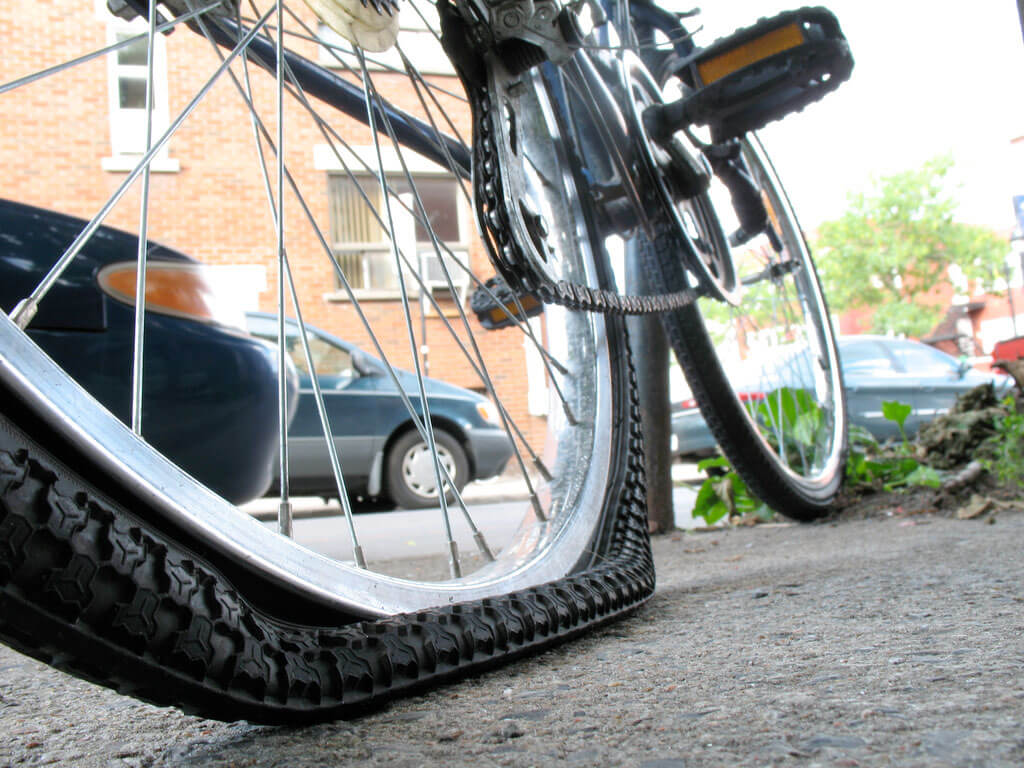
While they can be frustrating, fixing a flat tire isn’t terribly difficult. When riding, be sure to have a patch kit and bicycle tire release lever. These simple instructions can get you back on your bike quickly.
- Release the Brake – Before fixing the flat, you’ll need release the brake so that the wheel can be removed. The brake mechanism is right above the wheel. There are various types of brakes. If it has a know at the end of the pull-cable that catches on a notch in the caliper arm, squeeze the brake arms together to release the cable. For a quick-release lever (similar to an axle), open and release the brakes. Most mountain bikes have disc brakes and it’s important to be careful not to touch the rotor when opening the quick-release mechanism. It can extremely hot.

- Release the Wheel – After the break has been released, the wheel needs to be removed from the axle. To remove a front wheel, simply open the quick-release lever and unscrew the securing nut slightly on the opposite side as needed to release the tension that holds the wheel in place. Rear wheels are removed the same way, but the chain makes it a bit more complicated. Shift the gear in the smaller gear cog by adjust the shifter up then raising the bike. Then, spin its wheels until the gear-shift is complete. Pull back on the rear derailleur to give it some slack, then lift out the wheel with the other hand. The wheel should pop free! If you can’t find a quick release leaver, then the wheel is bolted on. Simply unscrew the bolts with a wrench and release the wheel.
- Check for Damage – Carefully inspect both the tire and the tube for the cause of the flat by running a cloth inside the tire. Any sharp objects will snag the fabric. Remove the debris. Visually check the tire tread for other culprits or large cuts. Be sure that no spokes or rough edges are rubbing along the inside of the metal rim.
- Identify the Cause of the Flat – First, check for obvious punctures or blowouts in the tube. Try inflating the tube so you can check for escaping air. Then, check the valve. If the valve stem or base is cut, cracked or severely worn, it may be leaking. If that’s the case, replace the entire tube. If the valve looks good, check the thin strip along the inside of your rim. Look for protruding spoke ends or areas where the strip may have come free and pinched the tube against the rim surface. Last, look for any embedded objects in the outside tread of the tire. Turn the tire inside out and do a full visual inspection of the inner surface, making your way slowly around the tire. Use a tweezer to remove any foreign debris.
- Repair or Replace the Tube – If the tire has sustained little or no permanent damage, as is often the case, your decision will be whether to repair or replace the tube. While repairing a damaged tube is cost effective, it should really just be used in an emergency situation. Replace the tube as soon as possible for maximum reliability. Patch kits come with step by step instructions.

- Put the Tube Back On – Pump a few pumps of air into the tube before inserting it back into the tire. Then, install the valve in the valve opening and work the rest of the tube into the tire all the way around. Pull the rubber bead of the tire back toward the metal rim. The tire bead should drop down into the metal rim. The bead will become trickier toward the end. You can push the bead with your thumbs to make it fit.
- Reinstall the Wheel – Simply reverse the procedure you used to remove it. Reattach the wheel to your frame dropouts, holding the derailleur out of the way if you’re reinstalling the rear wheel. Once the tire is attached to the wheel, it’s ready to be completely inflated. Look at the sidewall to find the recommended pressure. When inflating, make sure the tire is even and has no bulges or low spots.
- Reattach the Brakes!! – Don’t ever forget this step.
Be prepared for flats. Shop The House for patch and repair kits, tubes, tires, and pumps.








